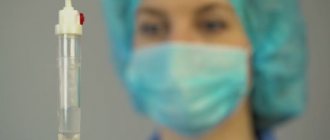The intestine is the longest part of the digestive tract, ensuring the digestion of food and the absorption of necessary substances and vitamins. It also participates in the processes of removing metabolic products from the body, producing hormones, and ensuring the patient’s immunity. Therefore, many diseases in women are accompanied by damage to the intestines, and at the same time, pathologies of the digestive system can lead to the development of diseases of other organs.
Important! The small and large intestines are located close to a woman’s reproductive organs – the uterus and ovaries. Therefore, inflammatory processes that are not treated in time can spread to them. As a result, a difficult situation arises, which often ends in surgery and infertility.
Intestinal diseases and their symptoms in women
Anatomy
It is known that most of all gastrointestinal pathologies (gastrointestinal tract, photo above) are directly related to the intestines.
Medicine does not stand still; many intestinal diseases have been studied for a long time and are easily treatable. There are also “mysterious” diagnoses, such as irritable bowel syndrome (IBS) and dysbiosis. Treatment methods for these diseases are quite controversial and the attitude of doctors towards them is ambiguous.
In this article, we will tell you about the anatomical structure, where the intestines are located and about its functional abilities, about the symptoms and treatment of various intestinal diseases, about how it hurts. And also about disease prevention and which specialist to contact at the first signs of disease.
The intestine is divided into two main segments - thick and thin:
- Small intestine - starts from the pylorus (pylorus) of the stomach, consists of the duodenum, jejunum and ileum (lower section of the small intestine), ends with the bauginian valve (ileocecal valve). It also serves as a connector between the intestines.
- The large intestine is divided into the following sections: the cecum is the first section of the large intestine, the colon is its middle part and ends with the rectum. The duodenum took over the production of digestive enzymes, secretion functions, mucus formation and hormone production.
This is useful to know! The intestines contain a huge number of microorganisms. The health of the gastrointestinal tract and the entire body depends to a large extent on the microflora and its composition. The duodenum is distinguished by its sterility, because most of the beneficial bacteria die when an acidic environment comes from the stomach. In the large intestine there are about five thousand species of microorganisms.
Why does a person need an intestine?
The main digestive process occurs in the small intestine, which is lined from the inside with a large number of tiny projections - villi, which absorb substances beneficial to the body from digested food.
From the stomach (in the form of crushed and partially digested gruel) it enters the duodenum, connected to the liver and pancreas. The liver secretes bile, a substance that can break down fats into glycerol and fatty acids.
Its accumulation occurs in the gallbladder attached to the liver. Simultaneously with the entry of food into the duodenum, bile is automatically pushed into the bile duct leading to the small intestine. The pancreas is responsible for the production of pancreatic juice, intended for processing carbohydrates, proteins and fats.
The final digestion of food occurs in the structures of the jejunum and ileum. Here, through the intestinal walls, nutrients are absorbed and enter the blood, delivering them to every cell of the body.
The work of the large intestine consists of absorbing water, forming feces from undigested food gruel residues and removing them from the body, accompanied by the release of intestinal gases.
The human intestine is a haven for many bacteria: both beneficial, involved in the digestive process, and pathogenic, capable of activating the processes of fermentation and putrefaction. When there is a deficiency of beneficial microflora, a condition called dysbiosis occurs.
Factors influencing the appearance and development of intestinal diseases
- presence of concomitant gastrointestinal diseases; intestinal infections;
- heredity;
- uncontrolled and long-term use of medications (the composition of the microflora is disrupted);
- unhealthy diet (fatty, fried, salty, little or no fiber);
- smoking and alcohol;
- extra pounds of body weight;
- lack of vitamins and microelements;
- stress;
- sedentary lifestyle.
There are factors beyond a person’s control, such as genetics, that cannot be eliminated. But other factors can be influenced - change your lifestyle, give up bad habits, lose weight.
According to statistics, more than 90% of the population of civilized countries of the world suffer from gastrointestinal diseases.
Rectal problems
Symptoms of rectal disease may not appear very clearly. There may be an asymptomatic course or very weak signs. Many diseases of this part of the intestine are accompanied by metabolic disorders, which are manifested by general fatigue, slow growth, and disturbances in the functioning of internal organs.
Standard signs of rectal pathologies are:
- soreness of the abdomen and anal area;
- pus in stool;
- blood in the stool;
- constant constipation;
- bloating of the abdomen with gases.
With blood loss, anemia often develops. Symptoms of emerging intestinal disease are often similar to other pathologies, so a specialist can make the correct diagnosis after a comprehensive examination.
Haemorrhoids
An unpleasant pathology that is acquiring unprecedented proportions in modern society. Hemorrhoids are dilation of veins in the rectum with the formation of specific nodes.
The causes of hemorrhoids can be a sedentary lifestyle, pregnancy, and lack of fiber in food.
Symptoms of hemorrhoids:
- itching, discomfort in the anus;
- pain in the lower abdomen;
- traces of blood during bowel movements or on linen or toilet paper;
- in the later stages, the patient can feel the fallen node with his hand and even set it in place.
The main mistake with this disease is late contact with a specialist, when good opportunities to treat the disease are missed.
There are effective methods for treating hemorrhoids that can quickly relieve a person from suffering. But the disease is considered delicate; sufferers are embarrassed to visit a doctor. Over time, the situation worsens and can lead to surgery, because there is a risk of pinching of the fallen nodes.
Crack
A small anal fissure appears on the wall of the anus. At first it is an ordinary tear of the skin, which changes over a chronic course - the edges begin to harden, the surface becomes covered with dense tissue. Various diseases of the intestine and all its parts can provoke the occurrence of anal fissure.
The crack will cause pain and bleeding. Moreover, the pain can be very severe and last for several hours after defecation. In some cases, it is impossible for a sick person to sit and it is difficult to walk, for example, to climb stairs. It is necessary to consult a doctor as soon as possible; over time, the disease will only develop and the pain will intensify.
General signs of intestinal diseases
When the intestines are affected, the symptoms and signs of the disease are of a different nature and are present regardless of the nature of their origin. Symptoms of a diseased intestine vary in nature:
- allergic;
- immune;
- motor;
- tumor;
- infectious.
Signs of intestinal diseases:
- pain, various locations in the abdominal area;
- diarrhea;
- constipation;
- flatulence (bloating);
- pathological impurities (mucus, blood) in stool;
- loss of appetite;
- sudden weight loss;
- painful and false urge to defecate;
- nausea and fecal vomiting.
Abdominal pain
Abdominal pain can be localized or intense in nature. They depend on the manifestation of pain during eating and bowel movements.
For example: With a disease of the small intestine, the patient experiences pain in the navel area. These pains are distinguished by a pulling and aching character, and when a spasm occurs, intestinal colic is observed.
Bursting, non-sharp pain is characteristic of a disease in the large intestine. There is practically no connection between pain and food intake. The pain subsides with stool and after passing gas.
Diarrhea
Diarrhea (diarrhea) is considered a pathological disease and is considered to be a symptom when stool becomes frequent, exceeding more than 3 times a day. The feces are liquid (watery), accompanied by pain, anal incontinence and frequent urge to go to the toilet are possible. Diarrhea is divided into two types: acute and chronic.
Chronic enterocolitis
Chronic enterocolitis is a simultaneous inflammation of both the small and large intestines, which is characterized by atrophy of the mucous membrane lining the inner surface of the intestines, which causes disruption of intestinal functions. Depending on the location of the inflammatory process, the disease is classified for the small (enteritis) and large intestines (colitis) separately.
The causes of chronic enterocolitis are due to the impact on the human body of the following pathological factors:
- long-term malnutrition;
- impaired immunity and metabolism;
- hormonal disorders, stress;
— intoxication with medications and chemicals;
- structural features of the intestine;
— intestinal viral infection;
— diseases of internal organs;
- intestinal and parasitic infections.
One of the most common pathogens of chronic enterocolitis is intestinal lamblia (photos of these parasites can be seen in the article). They can multiply quickly and cause giardiasis. Signs of the disease include diarrhea, excess gas, abdominal cramps and pain, nausea, and vomiting. Giardia, the photo of which is presented in the picture, exists in two forms: active and inactive. Active forms of parasites live in the human body; when released along with feces, they turn into an inactive form and spread the infection outside the body.
Chronic enterocolitis often results from untimely or poor-quality treatment of acute forms of inflammatory bowel processes. In addition, there is a risk of transmission of the disease by inheritance and in people who were bottle-fed in infancy.
Symptoms of the most common intestinal diseases
The most common symptoms of intestinal problems are inflammatory in nature. There are two forms of diseases - acute and chronic.
Ulcerative colitis
Ulcerative colitis. It is characterized as a chronic disease of the large intestine; when it occurs, the mucous membrane is affected.
The onset of pathology occurs in the lower part of the large intestine, gradually the inflammatory process rises higher and completely affects the entire large intestine.
During the inflammatory process, the mucous membrane is completely covered with ulcers, it becomes vulnerable and bleeding.
The causes of this disease have not been established. In narrow circles, experts attribute this pathology to hereditary, which occurs as a result of a genetic failure when the intestinal mucosa begins to decompose, and inflammation occurs against this background. But these are assumptions, there are no exact data.
Diagnosis of ulcerative colitis is carried out instrumentally, based on colonoscopy. The presence of erosive structures on the mucous membrane and the identified symptoms are direct confirmation of the disease. For a complete diagnosis, an x-ray with a contrast agent (barium) is prescribed.
Etiology
Intestinal diseases can be triggered by a fairly large number of etiological factors, and poor nutrition occupies a leading position on the list.
Intestinal diseases can be caused by the following etiological factors:
- unbalanced diet;
- alcohol abuse;
- genetic predisposition;
- bacterial and viral intestinal infections;
- weak immune system;
- eating incompatible foods;
- failure to maintain personal hygiene before eating food;
- insufficient quality of sanitary and thermal processing of products;
- systemic pathological processes;
- smoking, drug use;
- the result of prolonged or uncontrolled use of certain medications;
- exposure to stress, nervous feelings, excessive workload;
- habit of drinking carbonated drinks with food;
- frequent food poisoning;
- poisoning by toxins, heavy metals, poisons;
- excessive consumption of seasonings, especially spicy ones;
- consequences of surgical interventions.
Diseases of the large intestine can be caused by the following etiological factors:
- inflammatory processes in the colon area;
- polyp growth;
- formations of a benign or malignant form;
- physical inactivity, sedentary lifestyle, which leads to the development of hemorrhoids and other proctological diseases;
- obesity;
- mechanical damage to the anus, causing the formation of cracks;
- entry of a foreign body into the intestines;
- formation of fecal stones.
Fecal stones
Diseases of the colon, like diseases of the rectum, can develop asymptomatically for a long time, which leads to delayed diagnosis and the transition of the pathological process to the chronic stage.
At risk are people who work in hazardous industries, abuse fatty foods, have bad habits and bad heredity. Those who have too weak an immune system are more susceptible to intestinal diseases.
"Mysterious" bowel diseases
People have a lot of questions when they name the most “mysterious” diseases, IBS or dysbacteriosis. There is an opinion that the second disease, in principle, does not exist. And yet the symptoms of a diseased intestine in patients are present and very noticeable.
Dysbacteriosis
Disturbance in the intestines of the full composition of microflora is called dysbiosis. With a reduction in the number of beneficial bacteria or their complete disappearance (lacto- and bifido), the volume of opportunistic microflora increases.
For reference: The term Dysbacteriosis is used only in the Russian pharmaceutical market, by sellers promoting probiotics to the masses.
Dysbacteriosis is not classified as an independent disease. It is a syndrome of various developing diseases (with damage to the gastrointestinal tract, intoxication, allergic manifestations, immunodeficiency, vitamin deficiencies), against the background of stressful situations, depression. Symptoms include diarrhea, cramping pain, bad taste in the mouth, headache, fatigue, loss of appetite and sleep.
Causes of pathologies
The most common causes of intestinal diseases are:
- Diet violation. Eating low-quality food products not only leads to infectious intestinal diseases, but can also cause celiac disease, and the content of carcinogens in food can lead to the development of cancer pathology. Most often, prohibited foods are excessively fatty, spicy foods, and fast food.
- Bad habits. Drug addiction, smoking and alcoholism lead to a decrease in the immune response and, as a result, the growth of pathological flora in the intestinal lumen. Alcohol and smoking can cause peptic ulcers, abnormalities in the intestinal structure in children (if consumed during pregnancy), and the development of autoimmune and other pathologies.
- Stressful conditions. Frequent nervous shocks can cause cancer, the development of ulcerative defects of the mucous membrane, irritable bowel syndrome, and so on.
- Genetic reason. Most often, either the disease is inherited or the genetic code of the fetus is “broken.” Presumably this is the cause of ulcerative colitis, Crohn's disease, intestinal polyposis and other diseases.
- Taking certain medications. Leads to an imbalance of opportunistic and beneficial flora in the intestines; a side effect of some medications is impaired peristalsis. Medicines can be the main cause of the formation of ulcerations of the intestinal wall.
- Sedentary lifestyle. It is considered the main cause of the formation of hemorrhoids.
We recommend reading:
Methods for examining the small intestine, their advantages and disadvantages
Diagnosis of pathologies
To establish an exact disease of the small intestine, a (detailed diagnosis) instrumental examination is required, for this the following is used:
- Endoscopy – examination is carried out using an endoscope. It is introduced into the stomach through the oral cavity.
- Colonoscopy – diagnosis is carried out with a special probe to examine the colon.
- Radiography is a study of the condition of the intestines using photographs using a contrast agent.
- Fibroscopy is prescribed for a complete and detailed examination of the upper gastrointestinal tract. The procedure is carried out using a gastroscope, by inserting it into the esophagus.
- Irrigoscopy is an X-ray examination of the colon with the introduction of a special drug into it. During the study, the results remain on photographs (irrigograms).
Diagnostics
To determine the cause of the clinical picture, you will need to examine the intestines. Regardless of the symptoms, the first step is a physical examination, during which:
- the nature of the clinical picture is determined;
- personal and family history is collected;
- medical history is studied;
- information is collected about the patient’s nutrition, lifestyle, and work habits.
Conduct laboratory and instrumental diagnostic measures. Laboratory diagnostics to check the intestines for diseases include:
- general blood analysis;
- general urine analysis;
- general analysis of stool and occult blood;
- PCR test;
- Helibacteriosis test;
- ELISA test;
- pH-metry;
- test for tumor markers.
Instrumental diagnostics is based on the following activities:
- irrigoscopy;
- esophagogastroduodenoscopy;
- upper endoscopy;
- capsule endoscopy;
- Ultrasound of the abdominal organs;
- sigmoidoscopy;
- X-ray examination of the stomach with a contrast agent.
Capsule for endoscopy
This is a sample diagnostic list. The doctor will decide how to check the intestines for diseases on an individual basis, based on the collected anamnesis and the current clinical picture. The tactics of therapeutic measures will be determined depending on the results of the examination.
Bowel specialists
Which doctor should I contact if the proper functionality of the intestines is disrupted and there is a disease?
- Gastroenterologist . A specialist in the treatment of intestines in adults, and the entire gastrointestinal tract, identifies diseases and prescribes therapeutic treatment.
- Surgeon . A doctor who has received special training in diagnostic and surgical techniques, as well as in the treatment of pathologies and injuries.
- Oncologist . Specializes in detecting neoplasms, including the intestinal region.
- Proctologist . Specializes in the diagnosis and treatment of intestines.
- Additional specialists . Doctors of narrow specialization working in the areas of: ultrasound examinations (ultrasound), x-ray examinations and FGDS (fibrogastroduodenoscopy) diagnostic methods.
Tumors in the large intestine
Currently, malignant neoplasms of the large intestine are often diagnosed. This type of disease is caused by poor diet and consumption of refined foods. An intestinal tumor can occur as a complication of polyps, colitis, and other diseases of this area.
The difficulty of treating such intestinal diseases is that symptoms appear in the later stages. For example, polyps may not appear at all; they are discovered by chance during an X-ray examination. A tumor can also be found unexpectedly.
If the neoplasms are located on the left side, then the symptoms will be of a general nature of intestinal obstruction:
- abdominal pain in the form of contractions;
- blood in stool;
- constipation
With polyps or a tumor in the right intestine, the symptoms will be more general:
- heat;
- diarrhea;
- weight loss;
- general weakness.
Such signs of illness should prompt you to undergo an examination. After all, at an early stage, it is easier and faster to cure pathology.
Treatment
At the first symptoms characterizing intestinal diseases, you should immediately seek qualified help. During the treatment process, it is necessary to strictly follow the instructions, a strict diet and the course of taking medications prescribed by the doctor.
During small intestinal therapy, the patient needs to take antimicrobial drugs (probiotics). To improve intestinal function, you need to take courses: vitamin therapy and enzymes. Vitamins - to restore strength, enzymes - to normalize the function of intestinal absorption of nutrients.
To relieve inflammation and intoxication in the body, take:
- antibiotics;
- corticosteroids;
- immunomodulatory medications;
During the treatment process, if the result of therapy is negative, the doctor makes a decision on further surgical treatment.
Celiac disease
This pathology is also called gluten enteropathy. The cause is a congenital deficiency of a certain enzyme that breaks down gluten (it is part of the protein in all grains).
Residues from incompletely digested protein negatively affect the small intestine. Its cells exfoliate, the mucous membrane becomes thinner, and can no longer perform its functions - processing and absorption are impaired.
Symptoms of the disease:
- severe diarrhea;
- sudden loss of body weight;
- bruising on the skin;
- bleeding gums;
- pain in the bones, possible fractures;
- in severe cases, mental deviations are observed.
Manifestations of celiac enteropathy are confused with similar diseases. Only a good specialist can diagnose pathology.
Often the diagnosis is made when the disease has already become chronic. Patients with this disease have to follow a strict diet throughout their lives, but this makes it possible to maintain health.
Prevention
Intestinal diseases can be avoided by following a basic list of rules:
- proper nutrition. Eliminate everything harmful from your diet (fast food, salty, fried, fatty, baked goods). Include: vegetables, fruits, lean meats and poultry, fish;
- avoid stressful situations;
- completely eliminate alcohol and tobacco;
- for women, closely monitor the pelvic organs (if any manifestations of symptoms occur, immediately consult a doctor);
- wash vegetables and fruits thoroughly;
- engage in physical education;
- take vitamins;
- drink more fluids.
Dyskinesia of the large intestine
With this disease, the motor function of the organ is impaired. A separate disease or complication after pathology of the gastrointestinal system is possible. The basis for failure of the motor ability of the colon is often stressful situations, depressive states, and high anxiety regarding everyday problems.
Intestinal diseases are provoked by past infections, allergies to certain foods, and an unbalanced diet that contains few indigestible substances. Long-term dysbiosis increases the likelihood of developing dyskinesia.
The symptoms are:
- strong rumbling, not associated with the use of any product (may be the only symptom);
- abdominal pain, but it is difficult to determine the location and type of pain;
- diarrhea and constipation alternate;
- pain is noted in the back, heart, even in the joints, although there are no diseases of these organs.
The picture of the disease is often blurred; additional tests and examinations will be required to confirm the diagnosis.
Diverticulosis
In a sick person, small protrusions called diverticula form in the intestines. Residents of economically developed countries are most susceptible to such changes in the internal organ.
Every third resident of a large metropolis has a predisposition to this disease. The whole problem is that foods with fiber and coarse plant fibers are disappearing from the diet of modern people. Such a diet leads to constipation, and this is a direct risk of developing diverticulosis.
At the initial stage, intestinal disease, like others, does not manifest itself. Minor stool disturbances and mild pain throughout the abdomen may cause concern. Obvious manifestations begin when the release of contents from the diverticula is disrupted.
The signs will be:
- heat;
- diarrhea;
- mucus and blood in stool.
The main danger of this condition is intestinal bleeding, the likelihood of which increases with age. The diagnosis is confirmed by X-ray examination. It is important not to progress the disease to the stage of narrowing of the intestinal lumen; it is very difficult to treat such a condition.
Prevention plays an important role in this disease. The diet should be balanced and contain a sufficient amount of substances necessary for the intestines. To do this, you need to regularly eat fresh vegetables and fruits. You also need to constantly monitor bowel movements, notice the slightest deviations, and visit a doctor in a timely manner.
What are the basic principles of treatment?
The treatment regimen for gastrointestinal diseases depends on the specific case. Intestinal infections and inflammatory processes are treated differently.
Scientists have studied more than 30 viruses and bacteria that can disrupt the functioning of the digestive system. Infection in the intestines usually results in diarrhea, nausea, vomiting and severe abdominal cramps. The main task in the treatment of such diseases is to help the body overcome the pathogen and prevent dehydration.
For rotavirus infection, dysentery, salmonellosis and other similar diseases, antibiotics are prescribed, if necessary, antiparasitic drugs. A gentle diet aimed at restoring water-salt metabolism is required.
Treatment of inflammatory diseases includes:
- changing the usual diet - reducing fatty foods, fast food, refined foods, predominance of protein foods, fiber;
- taking probiotics and prebiotics - relevant for intestinal dysbiosis, beneficial bacteria populate the microflora and eliminate harmful microorganisms;
- the use of sorbents, antispasmodics and antimicrobial agents - used for colitis, enteritis to relieve pain and unpleasant symptoms (bloating, heartburn).
For constipation, laxatives are prescribed, but their use must be supervised by a specialist to prevent the development of dysbiosis. For diverticulosis, the doctor will prescribe the patient a diet, antiseptics, antispasmodics and anti-inflammatory drugs. Proctitis is treated with sulfonamides, cleansing enemas, and bed rest.
Surgical treatment is used exclusively for indications: removal of the appendix, rupture of a diverticulum (a small loop in the intestine), intestinal obstruction, benign and malignant tumors.
The effectiveness of treatment of intestinal diseases depends on proper diagnosis.
Treatment of the intestines at home
Your doctor will tell you how to treat inflammation. Therapy is aimed at eliminating the causes and relieving symptoms. To eliminate inflammatory processes, various groups of medications are used in combination with dietary nutrition and folk remedies.
Important!
You cannot self-medicate intestinal inflammation - without timely diagnosis and proper therapy, complications will arise that will have to be eliminated surgically.
Drug treatment
The choice of medications depends on the form and severity of the pathology, the presence of concomitant diseases. It will take a lot of time and effort to completely cure the disease.
What medications are used in treatment:
- Aminosalicylates – Mesalamine, Olsalazine sodium. Reduce the manifestation of the inflammatory process, prolong the remission stage.
- Anti-inflammatory drugs in the form of suppositories and enemas - Salofalk, in pediatrics they use Rektodelt. They allow you to quickly eliminate unpleasant symptoms due to rapid absorption.
- Corticosteroids in the form of tablets and suppositories - Prednisolone, Budesonide. They allow you to quickly stop the manifestations of an acute form of the inflammatory process. Despite their effectiveness, they have many side effects, so they can be taken for no more than 5 days.
- TNF inhibitors - Remicade. Prescribed for autoimmune pathologies.
- Immunomodulators – Immunal, Viferon. You need to take them for 2-3 months.
- Tablets with anti-inflammatory and antibacterial effects - Metronidazole, Mezavant, Salosinal. Helps get rid of pathogenic microorganisms.
- Antimicrobial and antifungal drugs - Ciprofloxacin, Phthalazol, Levomycetin, Nystatin.
- Anthelmintics – Vermox, Decaris. Prescribed for helminthic infestations.
- Enzyme preparations – Mezim, Creon. Helps improve digestion and absorption of food.
- Sorbents – Smecta, Polysorb. Cleanses the intestines of toxic substances.
Salofalk is an effective anti-inflammatory drug
Patients are required to be prescribed medications to relieve dyspeptic manifestations of the disease. Espumisan will help cope with flatulence, Loperamide and Nifuroxazide are intended to combat diarrhea, and for constipation Bisacodyl and Kafiol are prescribed. After taking antibiotics, you need to restore the intestinal microflora with the help of prebiotics and probiotics - Lactusan, Linex.
Therapy with folk remedies
To eliminate the manifestations of the disease, as an auxiliary therapy, decoctions and infusions of anti-inflammatory herbs are used, which are taken orally or used for enemas, and help improve well-being and beekeeping products.
Collection of herbs
For enteritis, a collection of 30 g of celandine, 60 g of chamomile inflorescences, 60 g of St. John's wort will help. To prepare the infusion you need 1 tbsp. l. Brew the mixture with 240 ml of boiling water, leave in a closed container for 10 hours. Take 120 ml of medication three times a day half an hour before meals. Duration of therapy is 10 days.
Herbal decoction normalizes intestinal health
Oatmeal broth
Oat decoction helps cope with gastrointestinal disorders.
How to cook:
- Rinse 180 g of oat grains several times.
- Pour 1 liter of warm water over the prepared raw materials.
- Simmer the mixture over low heat for an hour.
- Cover the pan and leave for 5 hours.
Oat decoction will help normalize the gastrointestinal tract
Drink 120 ml of healing drink in the morning and evening 40 minutes before meals.
Duration of treatment is 2–3 weeks.
Infusion of oats with milk
If a child’s intestines hurt, then you need to pour 150 g of washed oat grains into 400 ml of hot milk, pour into a thermos, and leave until it cools completely. Before going to bed, give 120 ml of the drink, continue treatment for 3-4 days.
Oats with milk are good for treating a child’s intestines
Flax seeds for intestinal inflammation
Flaxseed contains healthy mucus, which envelops the intestinal walls - pain disappears, stool normalizes. Brew 300 ml of boiling water for 10 g of raw material, leave for 10 minutes, shake well, strain. Drink 110 ml of medication every day before breakfast.
Flax seeds are very good for the intestines
How to relieve inflammation with propolis
To prepare the medicine, you need to pour 50 g of propolis into 500 ml of vodka, put it in a dark place for a week, shake vigorously every day. Half an hour before each meal, dilute 10 drops of tincture in 100 ml of warm water, duration of therapy is 10–15 days.
It is enough to consume 50–100 ml of high-quality honey daily to improve the condition of intestinal pathologies and reduce the likelihood of their occurrence.
Tincture with propolis will restore intestinal function
Diet for intestinal inflammation
Without a diet, it is almost impossible to cope with inflammation of the gastrointestinal tract. The basis of the diet should be seasonal vegetables, fruits, dairy products, meat and low-fat fish. Products should be boiled, stewed or steamed, and have a comfortable temperature.
Prohibited products:
- fast food, fatty, spicy, gift dishes;
- fresh white or rye bread - you can only eat yesterday’s baked goods;
- whole grain porridge, barley and wheat cereals;
- pasta – can be added in minimal quantities to soups;
- legumes;
- milk, cream, in the acute stage you should not drink fermented milk drinks;
- fatty meat, fish, sausages;
- canned food, sauces, carbonated drinks;
- raw vegetables and fruits.
You should not eat spicy food if you have intestinal inflammation.
Therapeutic nutrition involves reducing the amount of carbohydrates and fats and increasing the amount of proteins. It is necessary to observe the drinking regime - consume at least 2.5 liters of clean still water per day. The amount of salt should not exceed 8 g per day.
Analyzes
Well, above we briefly talked about the features of inflammation of the small intestine. Treatment will be discussed a little later, but for now we need to pay attention to the specifics of diagnosis.
First of all, the gastroenterologist collects the patient’s medical history, conducts an initial examination, and palpates the abdomen. Tests are required. And here's what they are:
- General blood analysis. Helps detect signs of inflammation. They are indicated by a high level of leukocytes and ESR.
- Stool analysis. With its help, enzymatic deficiency is determined, and the completeness of the digestive function is assessed. It is also possible to detect infectious lesions. Typically, fat, starch, and muscle fibers are found in the biomaterial.
- Biochemistry of blood. Allows you to identify signs of malabsorption syndrome.
We suggest you read: Chronic inflammation of the genitourinary system
Prevention and prognosis
Prevention measures include high-quality and balanced nutrition and adherence to food discipline. Drug therapy should be regulated by medical prescription; self-medication leads to adverse consequences.
After recovery, it is recommended to adhere to the doctor’s instructions , maintain a healthy lifestyle, stabilize the psycho-emotional background and eliminate negative factors.
Note! Unfortunately, the ulcerative process, even after quality treatment, can recur, so you should follow a gentle but balanced diet for life.
Folk remedies
Treatment with folk remedies is justified for chronic pathologies, since an acute process can only be cured with medication. The advantage of natural recipes is that they are inexpensive and absolutely safe. Many plants simultaneously exhibit several properties that are beneficial for intestinal inflammation. For example, chamomile has an astringent, antiseptic and wound healing effect.
For a positive effect, it is recommended to drink folk remedies for a long time and regularly. The following recipes are popular:
- A mixture of medicinal raw materials (chamomile, cumin, fennel) is poured with boiling water and filtered. The esophagus and intestines should be treated with a similar infusion three times a day after meals.
- Herbs such as linden, marshmallow, chamomile, and elecampane can reduce stomach acidity, which often causes pathological conditions in the gastrointestinal tract.
- The astringent and anti-inflammatory effect of oak bark effectively relieves unpleasant symptoms in the patient. A decoction is prepared from the plant, for which the raw material is poured with a liter of water, boiled and filtered. It is recommended to take half a glass up to 6 times a day.
- To prevent the intestines from becoming inflamed, you should drink a mixture of plantain juice and honey before meals.
- Olive oil is considered a natural laxative. You need to take 1 tablespoon every morning.
Inflammation of the small intestine, symptoms and treatment
Inflammation of the small intestine is defined in gastroenterology as a pathological process of damage to the mucous membrane of the small intestine, which is classified as enteritis. There are a huge number of reasons for the occurrence of enteritis. This may be a systematic malnutrition, or infectious processes that affect the gastrointestinal tract. Also, the physiological state of the intestines can be influenced by negative environmental factors.
Causes of inflammation of the small intestine
Below we list the main causes of inflammation of the small intestine:
- Violation of food culture
What is meant by eating disorder? First of all, this is not eating healthy, high-quality food - vegetables, fruits, steamed fish and meat, cereals, soups, but the abuse of fast food (burgers, carbonated drinks, steaks, etc.).
This also includes abuse of alcoholic beverages, as well as spicy, sour, and excessively salty foods.
Overeating is eating more food than is necessary to fully saturate the body.
- Long-term treatment with certain medications
If a person takes antibiotics or other medications for a long period of time, the instructions for use of which indicate a side effect such as an effect on the functioning of the gastrointestinal tract, then a severe inflammatory process cannot be ruled out.
In this case, the patient must contact the attending physician who prescribed the medications and indicate the presence of side effects.
- Infectious diseases of the gastrointestinal tract
- Severe hypothermia
Any inflammatory process in the intestines begins with the irritation of the mucous membrane of the gastrointestinal tract. At the same time, the person begins to feel a number of rather unpleasant signs and symptoms.
Symptoms of inflammation of the small intestine
The inflammatory process of the small intestine is always accompanied by a number of unpleasant symptoms. Therefore, a person can independently identify the disease and understand that he needs to see a gastroenterologist.
If your health has deteriorated significantly, you should urgently contact an ambulance, otherwise this condition may pose a threat to life and health.
The main symptoms of the inflammatory process include:
- Severe pain in the abdomen - as a rule, painful sensations are concentrated in the lower part;
- Vomit;
- Nausea;
- Painful diarrhea;
- State of general weakness;
- Pathological malaise;
- A sharp increase in body temperature;
- Chills and fever;
- Risk of collapse.
If you begin to palpate the abdominal cavity yourself, you will hear the intestines “rumbling”. A laboratory blood test reveals an increased leukocyte sedimentation rate, which indicates the presence of an inflammatory process in the body.
In women, a clear symptom of the inflammatory process of the small intestine is menstrual irregularities and sudden weight loss (in some cases, weight loss is reduced to minus 10 kg in a week or two).
If at least one of the above symptoms occurs, it is recommended to urgently consult a gastroenterologist.
The main stages of the inflammatory process of the intestines
Inflammation of the small intestine or enteritis manifests itself in humans in several stages, which differ in their origin, causes, and symptoms.
In particular, inflammation of the small intestine occurs in two stages - acute and chronic.
Let us describe the acute stage of enteritis. It usually manifests itself in such forms as:
- Viral;
- Allergic;
- Infectious;
- Toxic.
A person in the developing acute stage initially complains of such unpleasant symptoms as: severe fever, gag reflex, nausea, increased weakness, malaise (it is difficult for the patient to move independently).
The main cause of the chronic stage of inflammation of the small intestine is increased abuse of spicy, fatty, sour foods, as well as alcohol consumption in a chronic painful form.
In the chronic stage of inflammation of the small intestine, deterioration in well-being is reduced to a feeling of dull pain in the abdominal cavity.
Danger of enteritis
Gastroenterologists call inflammation of the small intestine extremely dangerous to human life and health. If you delay in seeing a doctor and do not carry out the necessary therapy, then this entire pathological process can play a cruel joke on a person.
Consequences of inflammation of the small intestine: internal intestinal bleeding (consequences - death), necrosis (death of intestinal tissue).
If the inflammatory process of the small intestine is ignored, it quickly progresses to the chronic stage.
Diagnosis of inflammation of the small intestine
To make a diagnosis of “inflammation of the small intestine,” a gastroenterologist must give a referral to:
- Stool analysis;
- General blood analysis;
- Take an X-ray of the intestines;
- Perform endoscopy of the postbulbar duodenum;
- Biopsy of the small intestine.
Treatment of small intestinal disease
If we talk about a full and intensive course of treatment, then the first thing is a therapeutic diet. It is forbidden to eat fried, salty food, fast food, drink alcohol, or smoke. Recommended - plenty of warm drinks, and also, if necessary, therapeutic fasting.
Among the medications it is necessary to highlight: Mezim-Forte, Creon, Pancreatin; anabolic steroid drugs - Nerobol, as well as Retabolil. Biologically active drugs aimed at normalizing intestinal microflora - Bifikol, Lactobacterin, Bifikol. To normalize stool, doctors prescribe Bismuth, Calcium Carbonate.
Interesting articles:
medportal.su
How does changing the functions of the large intestine affect health?
It is believed that by the age of forty, a person’s large intestine is already heavily clogged with fecal stones. They are formed from fossilized unremoved wastes that get stuck between the folds of the mucous membrane. When surgeons remove part of the intestine, in 70% of cases they find foreign material in it, worms, stones that have accumulated over many years.
The normal width of the lumen of the ascending colon reaches 8 cm, and the sigmoid colon is 2 times narrower. The deformation causes significant stretching. In this case, compression and displacement of neighboring organs in the abdomen occurs. Accordingly, their work is disrupted. Temporary constipation occurs in everyone.
It has been established that fecal stones do not move for years, “stick” to their place, disrupt the nutrition of the wall, and contribute to the penetration of toxins into the bloodstream. As a result, colon diseases develop. They are caused by the main damaging factors:
- inflammatory - damage to the mucous membrane of the intestinal wall (colitis);
- varicose veins and hemorrhoids - venous congestion, compression, circulatory failure;
- proliferation of polyps and malignant transformation - long-term action of toxins on a specific site.
Fecal stones are “swept” out of the intestines when bran is added to food
All types of violations are divided into:
- functional - when there are clinical manifestations, but there are no organic changes in the intestines, they are considered reversible;
- organic - always accompanied by anatomical signs and disruption of the physiological mechanisms of digestion.
Inflammatory pathology
Inflammatory diseases of the large intestine (colitis) occur both when pathogenic microorganisms enter (Shigella in dysentery) and when their own opportunistic flora is activated (Clostridium in pseudomembranous colitis). It has been established that E. coli can transform into pathogenic strains.
Pseudomembranous colitis
The disease is a serious complication of antibiotic therapy (less often occurs under the influence of treatment with cytostatics, immunomodulators, laxatives) and dysbacteriosis. Caused by overgrowth of clostridia in the large intestine. Considered to be a nosocomial infection.
Bacteria in normal numbers are not considered pathogenic. Having received the “majority”, they cause inflammation of the wall with the released toxin.
In places covered with films (membranes), all layers of the intestinal wall are destroyed up to the release of feces into the abdominal cavity
The disease is accompanied by severe intoxication, high fever, diarrhea, severe abdominal pain, vomiting, headaches, dehydration, severe electrolyte and protein disturbances, and depression of the cardiovascular system.
It is especially difficult to tolerate in old age, in the presence of other diseases. In the initial stage, symptoms disappear when medications are discontinued. In severe cases, hyperkalemia and death from cardiac arrest develop. Let's consider two diseases not associated with infection.
Ulcerative colitis
The disease refers to chronic lesions. Inflammation begins in the rectum and spreads upward to other parts of the large intestine. The mucous membrane is a surface covered with ulcers and bleeds easily. Usually the process does not go deeper than the submucosal layer.
This significantly increases the risk of transformation of ulcerative epithelium into polyps or intestinal cancer. The causes of the disease have not yet been established. The most likely hereditary predisposition, genetic and immune changes in the family.
Symptoms:
- frequent diarrhea, less often stool retention;
- pain of a constant nature, located in the left iliac region and above, decreases after defecation;
- at times, bloody discharge from the intestines;
- weakness, decreased performance, constant feeling of fatigue;
- weight loss
In the treatment of the disease, a strict diet is used with the exclusion of irritating foods and milk. Sulfasalazine is prescribed for long courses. If there is no effect, corticosteroids are added. Local therapy includes rectal suppositories with anesthesin for pain relief, with methyluracil, microenemas with herbal decoctions (chamomile, calendula).
Variants of the prevalence of ulcerative colitis
In severe cases, the bottom of the ulcer deepens and corrodes a nearby vessel. If there is intestinal bleeding, patients are operated on, resection (removal) of the affected area is performed, and the anus is removed to the abdominal wall. Surgery is vital for bleeding, but it does not stop the inflammatory process.
Crohn's disease
A disease of unknown origin that can affect the entire digestive tract. Teenage boys and young men are more often affected; the next “peak” of prevalence occurs after the age of 60 years. In 75% of cases, inflammation is localized in the area of the terminal ileum and the beginning of the large intestine (ileocolitis).
A study of Crohn's disease showed the importance of three factors:
Symptoms and treatment of Crohn's disease in adults
- heredity - confirmed by the distribution among twin brothers, the connection of gene mutations with ankylosing spondylitis (ankylosing spondylitis), and the isolation of a special mutant gene.
- infections - suspicions fall on the paratuberculosis bacterium, studies are being conducted on connections with viral and bacterial pathogens;
- immune disorders - evidenced by the detection of an increase in T-lymphocytes and antibodies to E. coli in the body of patients, but specific antigens have not yet been discovered.
The inflammatory process, unlike ulcerative colitis, spreads deeper, involving the entire intestinal wall and lymphatic vessels. Areas of lymphocyte accumulation have clear boundaries and alternate with normal tissue. Due to the compaction of the wall, the lumen narrows.
Ulcers on the mucous membrane look like slits and cracks. The formation of characteristic granulomas (tubercles) makes it look like a “cobblestone street”. This sign is used in differential diagnosis. The muscle layer is destroyed over time, abscesses and fistula tracts are formed, going into the peritoneum or neighboring organs, onto the skin of the abdomen.
Symptoms of the disease are usually divided into intestinal and extraintestinal. Intestinal manifestations include: prolonged diarrhea, pain most often in the right iliac region (masked as appendicitis), intensified after eating, radiating to the navel, throughout the abdomen, nausea and vomiting, bloating, weight loss (more often when the small intestine is involved).
How other organs are involved in the inflammatory process is unknown. Extraintestinal signs include:
- loss of appetite;
- constant fatigue;
- wave-like increase in temperature;
- in the mouth - aphthous stomatitis with very painful ulcers, bleeding;
- from the eyes - inflammation of the membranes (conjunctivitis, uveitis, keratitis);
- spinal spondylitis, inflammation of the joints of the arms and legs, development of stiffness;
- skin rashes in the form of erythema nodosum, pustules, vascular angiitis.
Characterized by fatty degeneration and cirrhosis of the liver, the formation of stones in the bile ducts, sclerosis of the ducts (the formation of a malignant tumor is possible). At the same time, cystitis, urolithiasis, pyelonephritis, amyloidosis occur in the urinary system, the kidney enlarges and forms hydronephrosis.
Fistulas are manifested by anal fissures, connections to the bladder, rectum, and in women with a uterus
Treatment is conservative and differs little from ulcerative colitis. The following are used as symptomatic help: enzymes, enterosorbents, probiotics, iron supplements for anemia, vitamins.
Alternative techniques include:
- a method of saturating the body with oxygen in a special chamber (hyperbaric oxygenation);
- plasmasorption and plasmapheresis;
- use of stem cells.
How to prevent complications
The symptoms of intestinal pathologies cannot be ignored. Some conditions, such as erosion and benign neoplasms, can develop into cancer. But it takes a long time to be treated and does not provide a 100% guarantee of recovery. In addition to severe discomfort, almost all diseases contribute to the appearance of signs of intoxication, and internal systems suffer from this.
During inflammatory reactions, the absorption function fades, and the person does not receive enough nutrients. If a patient has diarrhea, there is a risk of dehydration. Once the process has started, it becomes irreversible, so you can’t delay a visit to the doctor.
( 2 ratings, average: 5.00 out of 5)
Diagnostic methods
It is not possible to treat the intestines with universal remedies. First you need to find out where the pathology occurred and what caused it. The doctor will be helped by the results of the following tests and examinations:
- Clinical blood parameters - the values of ESR and leukocytes are important, which may indicate inflammation or an infectious process.
- Coprogram - allows you to identify abnormal inclusions in stool, draw conclusions about the functioning of the digestive tract and the amount of enzymes.
- Colonoscopy is an examination of the intestinal mucosa that helps determine the location of the problem.
- Bacteriological culture. In case of infectious etiology, the results of this analysis will help to select the correct treatment for intestinal inflammation with antibacterial drugs.
- FEGDS is a very unpleasant, but not painful, examination of the stomach and duodenum using a tube with a camera. This method allows you to take a sample for histology.
- Endoscopy with video capsule. A modern and informative way to study the condition of all parts of the digestive tract. Data from the ingested element is reflected on the computer within 24 hours.
What are the types of intestinal diseases?
Intestinal diseases are different, depending on the causes. Main groups of diseases:
- Infections appear when harmful microorganisms enter the body, which cause acute inflammation of the intestinal walls and are accompanied by intoxication. These intestinal diseases are caused by bacteria, viruses, and protozoa.
- Hereditary, or congenital, are associated with insufficient production of certain enzymes, which causes intolerance to certain foods.
- Non-infectious inflammatory diseases are usually chronic in nature. The inflammatory process occurs without the participation of pathogens; the main cause is autoimmune pathologies.
- Neurogenic diseases are associated with disturbances in the functioning of the nervous system, low resistance to stress, and disruption of the conduction of nerve impulses.
- Parasitic – caused by the activity of intestinal parasites. Parasites can be found in any part of the intestine, and can also affect the liver and bile ducts. Their presence leads to constant inflammation of the mucous membrane and intoxication.
- Tumors are associated with the appearance of neoplasms (benign or malignant).
- Adhesions are more common in women and are a consequence of inflammatory processes in the uterus and ovaries.
Inflammation of the mesentery of the small intestine
This disease deserves special attention. The mesentery is a kind of ligament that secures the abdominal organs. It is also responsible for transmitting nerve impulses through NS receptors, supporting the immune system and providing oxygen and nutrients.
Very rarely, the mesentery becomes inflamed on its own. This usually occurs against the background of peritonitis. It is almost impossible to recognize the pathology, since the clinical picture is varied. The most common and characteristic symptom is pain in the navel area, manifesting itself in varying intensities.
Unobvious symptoms include enlarged mesenteric lymph nodes, hyperemia and swelling of the inflamed area. Then foci of granulation tissue begin to develop, which later become scars.
We invite you to read: Inflammation of the knee meniscus: symptoms and effective treatment of knee meniscus
Diagnosis of diseases
There are several methods to identify problems in the intestinal tract. They can be divided into two large groups.
Laboratory tests:
- A general blood test can confirm the presence of inflammation, bleeding, and tumors.
- The coprogram forms a complete picture of the pathologies occurring in the tract. It shows the presence of worm eggs, muscle fibers, and connective tissues.
- A general urine test determines the cause of prolonged vomiting and diarrhea.
Instrumental examination methods provide the opportunity to see the severity of the process, assess its intensity, confirm the presence of dangerous complications, take tissue samples and even remove the tumor.
- Colonoscopy. This is done using an umbrella with a camera attached to the end. It displays the image on the monitor, so the doctor has the opportunity to visually examine the internal lumen of the intestine over a distance of two meters.
- CT scan. The result of the procedure is obtaining a three-dimensional model of the large intestine, on which all pathological changes are visible. This type of examination allows you to make accurate diagnoses and develop effective treatment regimens.
- Sigmoidoscopy. A procedure that allows you to examine the colon at a distance of 30 cm from the anus.
- Balloon enteroscopy. A complex painful procedure involving the insertion of an endoscope through the oral cavity. Prescribed for suspected tumors, bleeding and Crohn's disease.
- Capsule endoscopy. Used to study the small intestine. The patient swallows a capsule with a miniature video camera. It moves throughout the intestinal tract, records information and transfers it to a special carrier.
The choice of instrumental technique depends on the expected diagnosis and the patient’s condition.
Can there be a fever with intestinal inflammation?
If the inflammation is acute, which is caused by an intestinal infection, is accompanied by vomiting and diarrhea, the temperature can rise to 38-39 degrees .
It usually decreases on the second or third day of the disease, after the body has been cleansed of pathogens. When using antibacterial drugs, a decrease in temperature and improvement in well-being occurs faster. Another article on this topic: How to cure constipation at home using folk remedies?
An increase in temperature also occurs with appendicitis (pain is localized in the right side of the abdomen).
In women, abdominal pain associated with high fever requires additional differential diagnosis.
Chronic intestinal diseases can occur without an increase in temperature at all or against the background of an increase in temperature to subfebrile levels.











